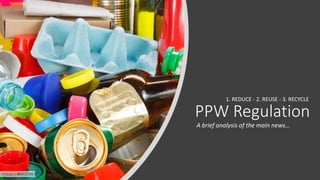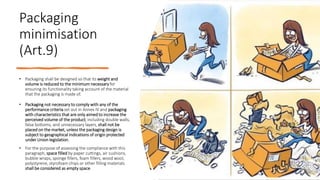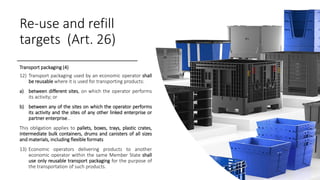- 1. PPW Regulation
A brief analysis of the main news…
1. REDUCE - 2. REUSE - 3. RECYCLE
- 2. Choice of the instrument
Regulation instead of a
Directive
“Differing national approaches to transposition and unilateral
packaging policy measures by certain MS have led to uneven
national regulatory frameworks”.
“Diverse national rules reduce the effectiveness of the policy
and put the effective establishment of a circular economy in
jeopardy”
“The regulatory failures of the current Directive has made it
clear that harmonisation is necessary…”
A Regulation will ensure obligations are implemented at the
same time and in the same way in all 27 Member States.”
- 3. Reasons for and objectives
of the proposal (1)
“Packaging is also a key environmental concern. It is
one of the main users of virgin materials (40 % of
plastics and 50 % of paper used in the EU is destined
for packaging) and accounts for 36 % of municipal
solid waste. The increased use of packaging coupled
with low re-use and recycling rates hamper the
development of a low-carbon circular economy.
Packaging increased in recent years faster than the
gross national income, which leads to soaring CO2-
and other emissions and the overexploitation of
natural resources, biodiversity loss and pollution.”
- 4. Reasons for and objectives
of the proposal (2)
“From 2012 till 2020, the share of unrecyclable
packaging has grown significantly. Furthermore,
technically recyclable packaging is often not
recycled because the processes needed for its
collection, sorting and recycling are not available in
practice or not cost-efficient, or the output is not of
sufficient quality to meet the demand in end markets
of secondary raw materials”
- 5. Reasons for and objectives
of the proposal (3)
The Parliament’s resolution of 10 February 2021 on the
new CEAP, reiterated the objective to make all packaging
reusable or recyclable in an economically viable way by
2030 and called on the Commission to present a
legislative proposal that includes:
• waste reduction measures;
• targets and requirements to reduce excessive
packaging;
• measures to improve recyclability and minimise the
complexity of packaging;
• measures to increase recycled content;
• measures to phase out hazardous and harmful
substances;
• measures to promote reuse;
- 6. Reasons for and objectives
of the proposal (4)
“The current legislation has failed to achieve its
environmental and internal market objectives. The
impact assessment detected three main problems:
(1)Growing packaging waste generation …
(2)Barriers to packaging recycling and re-use …
(3)Low recycling quality in plastic packaging and use
of secondary raw materials …
- 7. All packaging must be recyclable by 2030 (Art. 6)
Article 6 requires packaging to be recyclable and sets out what
requirements will need to be met in a two-stepped approach:
• as of 1/1/2030, packaging will have to comply with specific
design for recycling criteria and
• as of 1/1/2035 the requirements will be further adjusted to
ensure that recyclable packaging is also sufficiently and
effectively collected, sorted and recycled (‘recycled at scale’).
The criteria for the design of recycling and the methodology to
assess if packaging is recycled at scale will be established in
delegated acts to be adopted by the Commission.
- 8. Recycling targets
(Art. 46) unchanged
Packaging waste exported out of the Union shall be calculated
as recycled …. only if the exporter can prove that recycling took
place under conditions that are broadly equivalent to those
prescribed by the relevant Union legislation. (cfr. Art.47 (5))
2025 2030
Overall packaging recycling target 65% 70%
plastics 50% 55%
wood 25% 30%
ferrous metals 70% 80%
aluminum 50% 60%
glass 70% 75%
paper and cardboard 75% 85%
- 9. Minimum recycled
content in plastic
packaging (Art.7)
The plastic part in packaging shall contain the following
minimum percentage of recycled content recovered from post-
consumer plastic waste, per unit of packaging.
2030 2040
a) Contact sensitive packaging made from (PET) as
the major component
30%
50%
b) Contact sensitive packaging, except single use
plastic beverage bottles, made from plastic
materials other than PET
10%
c) Single use plastic beverage bottles 30% 65%
d) Other Packaging 35% 65%
NB1: These targets do not apply to compostable plastic packaging.
NB2: By 1 January 2030 EPR fees shall be modulated based on the percentage of recycled contentused in the packaging.
NB3. Where justified by the lack of availability or excessive prices of specific recycled plastics …. the Commission shall be empowered to
adopt a delegated act to revise the targets by adjusting the minimum percentages accordingly.
- 10. Minimum recycled
content in other (non-
plastic) packaging
(Art.7(11))
By 8 years after the date of entry into force of this Regulation, the
Commission shall review the situation regarding the use of recycled
packaging materials in packaging other than plastics and, on this basis, assess
the appropriateness of establishing measures, or setting targets, for increasing
the use of recycled content in such other packaging, and where necessary
present a legislative proposal.
- 11. Compostable packaging
(Art. 8)
By 24 months from the entry into force of this Regulation
• tea bags
• filter coffee pods and pads disposed together with the used coffee products
• sticky labels attached to fruit and vegetables
• very lightweight plastic carrier bags
shall be compostable in industrially controlled conditions in bio-waste treatment
facilities.
Where appropriate waste collection schemes and waste treatment infrastructure
are available to ensure that such packaging enters the organic waste management
stream, MS, are empowered to require that lightweight plastic carrier bags shall be
made available on their market … only if it can be demonstrated that they have
been entirely manufactured from compostable plastic polymers.
Packaging other than that shall not be manufactured from compostable plastic
polymers
By 24 months from the date of entry into force of this Regulation, packaging other
than that referred to in paragraphs 1 and 2, including packaging made of
biodegradable plastic polymers, shall allow material recycling without affecting the
recyclability of other waste streams.
- 12. Packaging
minimisation
(Art.9)
• Packaging shall be designed so that its weight and
volume is reduced to the minimum necessaryfor
ensuring its functionality taking account of the material
that the packaging is made of.
• Packaging not necessary to comply with any of the
performance criteria set out in Annex IV and packaging
with characteristics that are only aimed to increase the
perceived volume of the product, including double walls,
false bottoms, and unnecessary layers, shall not be
placed on the market, unless the packaging design is
subject to geographical indications of origin protected
under Union legislation.
• For the purpose of assessing the compliance with this
paragraph, space filled by paper cuttings, air cushions,
bubble wraps, sponge fillers, foam fillers, wood wool,
polystyrene, styrofoam chips or other filling materials
shall be considered as empty space.
- 13. Obligation related to
excessive packaging
(Art. 21)
1) Economic operators who supply products to a final
distributor or an end user in grouped packaging,
transport packaging or e-commerce packaging, shall
ensure that the empty space ratio is maximum 40%
2) Economic operators using sales packaging as e-
commerce packaging shall be exempted from the
obligation laid down in paragraph 1. They shall
nevertheless ensure that such sales packaging complies
with the requirements in Article 9
- 14. Requirements for
reusable packaging
Article 10 lays down the requirements for reusable
packaging. One of the requirements is e.g. that the
packaging is conceived, designed and placed on the
market with the objective to be re-used or refilled a
maximum number of times. Reusable packaging must
be also part of a system for re-use compliant with the
minimum conditions as set out in Annex VI of this
Regulation.
- 15. Labelling, marking and
information requirements
Article 11 requires that packaging is marked with a label
containing information on its material composition in order to
facilitate consumer sorting. The same labels shall be placed on
waste receptacles for the consumer to easily identify the
appropriate disposal route. Harmonized label shall be designed
also to inform, at the choice of the manufacturer, about the
recycled content in plastic packaging. Reusable packaging shall
bear a QR code or other type of data carrier giving access to the
relevant information facilitating its re-use.
- 16. Restrictions on
use of certain
packaging formats
(Art. 22)
Economic operators shall not
place on the market
packaging in the formats and
for the purposes listed in
Annex V.
Packaging format Restricted use Illustrative example
1. Single-use plastic grouped packaging
Plastic packaging used at retail level to group
goods sold in cans, tins, pots, tubs, and packets
designed as convenience packaging to enable or
encourage end users to purchase more than one
product. This excludes grouped packaging
necessary to facilitate handling in distribution.
Collation films, shrink wrap
2. Single use plastic packaging, single use
composite packaging or other single
use packaging for fresh fruit and
vegetables
Single use packaging for less than 1.5 kg fresh fruit
and vegetables, unless there is a demonstrated
need to avoid water loss or turgidity loss,
microbiological hazards or physical shocks.
Nets, bags, trays, containers
3. Single use plastic, single use
composite packaging or other single
use packaging
Single use packaging for foods and beverages filled
and consumed within the premises in the HORECA
sector, which include all eating area inside and
outside a place of business, covered with tables
and stools, standing areas, and eating areas
offered to the end users jointly by several
economic operators or third party for the purpose
of food and drinks consumption.
Trays, disposable plates and cups,
bags, foil, boxes
4. Single use packaging for condiments,
preserves, sauces, coffee creamer,
sugar, and seasoning in HORECA sector
Single use packaging in the HORECA sector
containing individual portions or servings, used for
condiments, preserves, sauces, coffee creamer,
sugar and seasoning, except such packaging
provided together with take-away ready-prepared
food intended for immediate consumption
without the need of any further preparation.
Sachets, tubs, trays, boxes
5. Single use hotel miniature packaging
For cosmetics, hygiene and toiletry products of
less than 50 ml for liquid products or less than
100 g for non-liquid products.
Shampoo bottles, hand and body
lotion bottles, sachets around
miniature bar soap
- 17. Re-use and refill
targets (Art. 26)
Article 26 lays down a number of
targets on re-use and refill for
different sectors and packaging
formats. It also establishes
exemptions from the obligation to
meet the re-use and refill targets.
The Commission may adopt
delegated acts laying down more
specific re-use targets and further
exemptions.
- 18. Re-use and refill
targets (Art. 26)
Transport packaging (1)
1) From 1 January 2030, economic operator making large
household appliances (e.g. washing machines, dishwashers,
fridges, ovens etc…) available on the market for the first
time within the territory of a Member State shall ensure
that 90% of those products are made available in reusable
transport packaging within a system for re-use.
7) Economic operators using transport packaging in the form of
pallets, plastic crates, foldable plastic boxes, pails and drums
for the conveyance or packaging of products in conditions
other than provided for under paragraphs 12 and 13 shall
ensure that:
a) from 1 January 2030, 30% of such packaging used is reusable
packaging within a system for re-use;
b) from 1 January 2040, 90% of such packaging used is reusable
packaging within a system for re-use.
- 19. Re-use and refill targets
(Art. 26)
- 20. Re-use and refill
targets (Art. 26)
Transport packaging (3)
10)Economic operators using grouped
packaging in the form of boxes, excluding
cardboard, used outside of sales packaging
to group a certain number of products to
create a stock-keeping unit shall ensure that:
a) from 1 January 2030, 10% of such packaging
used is reusable packaging within a system
for re-use;
b) from 1 January 2040, 25% of such packaging
they used is reusable packaging within a
system for re-use.
- 21. Re-use and refill
targets (Art. 26)
Transport packaging (4)
12) Transport packaging used by an economic operator shall
be reusable where it is used for transporting products:
a) between different sites, on which the operator performs
its activity; or
b) between any of the sites on which the operator performs
its activity and the sites of any other linked enterprise or
partner enterprise…
This obligation applies to pallets, boxes, trays, plastic crates,
intermediate bulk containers, drums and canisters of all sizes
and materials, including flexible formats
13) Economic operators delivering products to another
economic operator within the same Member State shall
use only reusable transport packaging for the purpose of
the transportation of such products.
- 22. Re-use and refill
targets (Art. 26)
Cold and hot beverages filled into a
container at the point of sale for take-
away
• from 1 January 2030 20% of those
beverages are made available in
reusable packaging within a system for
re-use or by enabling refill;
• from 1 January 2040 80% of those
beverages are made available in
reusable packaging within a system for
re-use or by enabling refill;
- 23. Re-use and refill
targets (Art. 26)
Take-away ready-prepared food
A final distributor that is conducting its business
activity in the HORECA sector and that is making
available on the market […] in sales packaging take-
away ready-prepared food, intended for immediate
consumption without the need of any further
preparation, and typically consumed from the
receptacle, shall ensure that:
• from 1 January 2030 10% of those products are
made available in reusable packaging within a
system for re-use or by enabling refill;
• from 1 January 2040 40% of those products are
made available in reusable packaging within a
system for re-use or by enabling refill;
- 24. Re-use and refill
targets (Art. 26)
Non-alcoholic beverages (water, water with added
sugar, water with other sweetening matter,
flavoured water, soft drinks, soda lemonade, iced
tea and similar beverages which are immediately
ready to drink, pure juice, juice or must of fruits or
vegetables and smoothies without milk and non-
alcoholic beverages containing milk fat)
• from 1 January 2030 10% of those products are
made available in reusable packaging within a
system for re-use or by enabling refill;
• from 1 January 2040 25% of these goods are
made available in reusable packaging within a
system for re-use or by enabling refill.
- 25. Re-use and refill
targets (Art. 26)
Alcoholic beverages
Alcoholic beverages in the form of beer, carbonated
alcoholic beverages, fermented beverages other than
wine, aromatised wine products and fruit wine, products
based on spirit drinks, wine or other fermented
beverages mixed with beverages, soda, cider or juice
• from 1 January 2030 10% of those products are made
available in reusable packaging within a system for re-
use or by enabling refill;
• from 1 January 2040 25% of those products are made
available in reusable packaging within a system for re-
use or by enabling refill.
- 26. Re-use and refill
targets (Art. 26)
Alcoholic beverages (wine)
Alcoholic beverages in the form of wine
• from 1 January 2030 5% of those
products are made available in reusable
packaging within a system for re-use or
by enabling refill;
• from 1 January 2040 15% of those
products are made available in reusable
packaging within a system for re-use or
by enabling refill;
- 27. Prevention of packaging
waste (Art. 38)
Each Member State shall reduce the
packaging waste generated per capita, as
compared to the packaging waste generated
per capita in 2018 as reported to the
Commission, by:
a) 5% by 2030;
b) 10 % by 2035;
c) 15% by 2040.
- 28. Deposit Return Systems
(Art. 44)
Article 44 requires a deposit and return system (DRS) for
single-use plastic beverage bottles with the capacity of up to
three litres and single-use metal and aluminium beverage
containers with a capacity of up to three litres. It also lays
down exemptions to this rule. By 1 January 2029, Member
States must ensure that all DRS follow the minimum
requirements set out in Annex X. Member States are also
allowed to include glass in the DRS and should ensure that
DRS for single-use packaging formats, in particular for single-
use glass beverage bottles, where technically and
economically feasible, are equally available for reusable
packaging
Exemption: A Member State may be exempted from the
obligation under paragraph 1 if the collection rate of the
respective packaging format … is above 90% by weight of
such packaging placed on the market on the territory of that
Member State in the calendar years 2026 and 2027.
- 29. Thanks for your attention
Paolo Azzurro
Circular economy area manager at ANCI Emilia-Romagna
paolo.azzurro@anci.emilia-romagna.it






















![Re-use and refill
targets (Art. 26)
Take-away ready-prepared food
A final distributor that is conducting its business
activity in the HORECA sector and that is making
available on the market […] in sales packaging take-
away ready-prepared food, intended for immediate
consumption without the need of any further
preparation, and typically consumed from the
receptacle, shall ensure that:
• from 1 January 2030 10% of those products are
made available in reusable packaging within a
system for re-use or by enabling refill;
• from 1 January 2040 40% of those products are
made available in reusable packaging within a
system for re-use or by enabling refill;](https://image.slidesharecdn.com/ppwregulation-presentation-221214085313-d90f595f/85/PPW-Regulation-Presentation-pdf-23-320.jpg)





